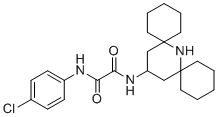
HAR-171
CAS No. 1349902-37-9
HAR-171( HAR171 )
Catalog No. M11415 CAS No. 1349902-37-9
HAR-171 is a small molecule gp120-CD40 blocker that acts as a highly potent HIV entry inhibitor with IC50 of 0.43 uM against YTA48P virus.
Purity : >98% (HPLC)
 COA
COA
 Datasheet
Datasheet
 HNMR
HNMR
 HPLC
HPLC
 MSDS
MSDS
 Handing Instructions
Handing Instructions
| Size | Price / USD | Stock | Quantity |
| 100MG | Get Quote | Get Quote |


|
| 200MG | Get Quote | Get Quote |


|
| 500MG | Get Quote | Get Quote |


|
| 1G | Get Quote | Get Quote |


|
Biological Information
-
Product NameHAR-171
-
NoteResearch use only, not for human use.
-
Brief DescriptionHAR-171 is a small molecule gp120-CD40 blocker that acts as a highly potent HIV entry inhibitor with IC50 of 0.43 uM against YTA48P virus.
-
DescriptionHAR-171 is a small molecule gp120-CD40 blocker that acts as a highly potent HIV entry inhibitor with IC50 of 0.43 uM against YTA48P virus with no significant cytotoxicity (CC50>120 uM).
-
In Vitro——
-
In Vivo——
-
SynonymsHAR171
-
PathwayMicrobiology/Virology
-
TargetHIV
-
RecptorHIV
-
Research Area——
-
Indication——
Chemical Information
-
CAS Number1349902-37-9
-
Formula Weight417.978
-
Molecular FormulaC23H32ClN3O2
-
Purity>98% (HPLC)
-
Solubility——
-
SMILES——
-
Chemical NameN1-(4-chlorophenyl)-N2-(7-azadispiro[5.1.58.36]hexadecan-15-yl)oxalamide
Shipping & Storage Information
-
Storage(-20℃)
-
ShippingWith Ice Pack
-
Stability≥ 2 years
Reference
1. Narumi T, et al. Bioorg Med Chem. 2013 May 1;21(9):2518-26.
2. Ohashi N, et al. ChemMedChem. 2016 Apr 19;11(8):940-6.
molnova catalog



related products
-
TAT
TAT (YGRKKRRQRRR) is derived from the transactivator of transcription (TAT) of human immunodeficiency virus-1 (HIV-1) and is a cell-penetrating peptide.
-
Tenofovir Disoproxil
Tenofovir Disoproxil is a nucleotide reverse transcriptase inhibitor to treat HIV and chronic Hepatitis B.
-
ZBMA-1
ZBMA-1 is a potent HIV-1 replication inhibitor (IC50=1.01 uM) that efficiently protects APOBEC3G protein by targeting Vif-APOBEC3G complex.



 Cart
Cart
 sales@molnova.com
sales@molnova.com


